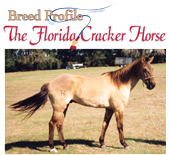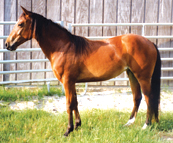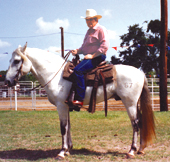|
Return to Breed Profiles Main Page
 The
Florida Cracker Horse The
Florida Cracker Horse
by Audrey Lee
When I first started researching this obscure breed, I had never
heard of Florida Cracker, as I imagine you hadn't until today.
What's in a Name?
My first question was, "Why are they called Cracker Horses?" Turns
out "Cracker" horses are named for the people who used and depended
upon them. As familiar a symbol as the "lasso" is of the American
cowboy, the long whip was of traditional Spanish cattle ranchers
and herdsmen. Those who rode after the wily Spanish cattle cracked
their long whips in the air to move them - and were called "Crackers".
The horses have also been known as the Florida horse, Woods pony,
Marsh Tacky, Seminole pony, Prairie Pony and Florida Cow Pony.
Florida  Cracker
Horses come in every color known to horse, although solid colors
and greys are predominant. They typically have a refined head with
an intelligent appearance and keen eyes. The neck should be well
defined, without excessive crest, the back short and strong, with
a well-sprung rid cage. There is a slope to the croup down to a
medium tail set. Average height is from 13.5 to 15 hands and the
horses weigh from 700 to 1000 pounds. Cracker
Horses come in every color known to horse, although solid colors
and greys are predominant. They typically have a refined head with
an intelligent appearance and keen eyes. The neck should be well
defined, without excessive crest, the back short and strong, with
a well-sprung rid cage. There is a slope to the croup down to a
medium tail set. Average height is from 13.5 to 15 hands and the
horses weigh from 700 to 1000 pounds.
Besides their natural herding instinct, Florida Crackers were prized for their unusual strength and endurance and a naturally fast walk. Though not all Crackers are considered gaited, many if not most, perform a gait called a "Coon Rack" in proper Cracker dialect. Their ancestry is similar to other gaited breeds, so it should be no surprise that many Crackers have the natural ability to gait.
Castaways
Descended from escaped or liberated horses brought to the New World
during the Spanish explorations and conquests,  Cracker
Horses carry mixed blood. North African Barb, Spanish Sorraia, Andalusian,
Spanish Jennet and other Iberian breeds contributed to their genetic
base. This makes them very similar to the Spanish Mustang, Criollo,
Peruvian Paso and Paso Fino, which also developed from horses introduced
by the Spanish into the Caribbean Islands, Cuba, and the Americas. Cracker
Horses carry mixed blood. North African Barb, Spanish Sorraia, Andalusian,
Spanish Jennet and other Iberian breeds contributed to their genetic
base. This makes them very similar to the Spanish Mustang, Criollo,
Peruvian Paso and Paso Fino, which also developed from horses introduced
by the Spanish into the Caribbean Islands, Cuba, and the Americas.
In the territory that became Florida, Cracker Horses evolved mostly through natural selection as the horses roamed freely. Survival in this environment meant adapting to its extremes, and the Cracker Horse became vital part in Florida's heritage.
Though a fixture in Florida's long-standing cattle ranching industry, the
little, quick and catty horses were devastated by a quirk in that
very industry. During the "Dust Bowl" years of 1930's, government
programs encouraged moving cattle herds out of areas hardest hit
by the droughts into the lush grasslands of Florida. The great influx
of cattle should have been a  boon
to the naturally gifted cow ponies, except for the parasitic screwworm
that came with the cattle and flourished in the warm, humid climate.
The entire cattle industry changed, jeopardizing the place of the
Cracker. Where once a small, agile horse was perfect for chasing,
turning and stopping cows, now bigger, stouter horses were needed
to rope and hold them for treatment against the parasite. Suddenly,
the Florida Cracker cow horse was obsolete. boon
to the naturally gifted cow ponies, except for the parasitic screwworm
that came with the cattle and flourished in the warm, humid climate.
The entire cattle industry changed, jeopardizing the place of the
Cracker. Where once a small, agile horse was perfect for chasing,
turning and stopping cows, now bigger, stouter horses were needed
to rope and hold them for treatment against the parasite. Suddenly,
the Florida Cracker cow horse was obsolete.
Preservation
With an estimated worldwide population of 2,000 and less than 100 new registrations annually, the Florida Cracker is considered rare - but lucky.
The breed has survived over the years as the result of a few families who kept the distinct bloodlines. Families named Ayers, Harvey, Bronson, Partin, Matchetts and Whaley, among others, maintained most of the foundation stock of the breed.
In 1984, John Ayers donated a group of horses to the Florida State Department of Agriculture and Consumer Services to start the Withlacoochee State Forrest Cracker herds.
In 1985, the Friends of the Paynes Prairie, Inc., purchased six mares and a stallion from Ayers, and released them on the Paynes Prairie State Preserve (a 21,000 acre savanna, once home to thousands of free roaming Florida Crackers).
In 1989, the Florida Cracker Horse Association was founded as a non-profit, volunteer operated corporation. Uniting Cracker Horse owners and breeders was the biggest step!
In 1990, evaluations were started to determine which horses would be accepted.
In 1991, the Florida Cracker Horse Registry began registering horses under strict guidelines, in an effort to preserve purity of the bloodlines. Registry by-laws dictate two categories under which horses may be registered: The Foundation Series and the Cracker Series (descendants of the Foundation horses).
In June of 1997, there were 131 horses registered as Foundation Series and 139 registered as Cracker Series.
In June of 2000, registered horses included 139 Foundation Series and 285 Cracker Series. Projections are that the total will reach 750 registered horses by 2005.
The Cracker Horse preservation effort is succeeding. Their numbers are slowly, but steadily increasing. New breeding herds have been started and more will begin as breeding stock becomes available. The general public is becoming aware that this unique breed is a living part of Florida's heritage, and deserving of a place in its future.
Although primarily used as cow ponies, in the frontier days they were used for anything from pulling wagons and plows to general transportation. Today they find their place in other activities such as team penning, roping, trail riding and endurance riding. You name it; a Cracker has probably done it, or will!
Sam Getzen, of the Florida Cracker Horse Association provided the information and photos for this article. For more information contact The Florida Cracker Horse Association, P.O. Box 186, Newberry, FL 32669, phone: (352) 472-2228
|


 The
Florida Cracker Horse
The
Florida Cracker Horse Cracker
Horses come in every color known to horse, although solid colors
and greys are predominant. They typically have a refined head with
an intelligent appearance and keen eyes. The neck should be well
defined, without excessive crest, the back short and strong, with
a well-sprung rid cage. There is a slope to the croup down to a
medium tail set. Average height is from 13.5 to 15 hands and the
horses weigh from 700 to 1000 pounds.
Cracker
Horses come in every color known to horse, although solid colors
and greys are predominant. They typically have a refined head with
an intelligent appearance and keen eyes. The neck should be well
defined, without excessive crest, the back short and strong, with
a well-sprung rid cage. There is a slope to the croup down to a
medium tail set. Average height is from 13.5 to 15 hands and the
horses weigh from 700 to 1000 pounds. Cracker
Horses carry mixed blood. North African Barb, Spanish Sorraia, Andalusian,
Spanish Jennet and other Iberian breeds contributed to their genetic
base. This makes them very similar to the Spanish Mustang, Criollo,
Peruvian Paso and Paso Fino, which also developed from horses introduced
by the Spanish into the Caribbean Islands, Cuba, and the Americas.
Cracker
Horses carry mixed blood. North African Barb, Spanish Sorraia, Andalusian,
Spanish Jennet and other Iberian breeds contributed to their genetic
base. This makes them very similar to the Spanish Mustang, Criollo,
Peruvian Paso and Paso Fino, which also developed from horses introduced
by the Spanish into the Caribbean Islands, Cuba, and the Americas.
 boon
to the naturally gifted cow ponies, except for the parasitic screwworm
that came with the cattle and flourished in the warm, humid climate.
The entire cattle industry changed, jeopardizing the place of the
Cracker. Where once a small, agile horse was perfect for chasing,
turning and stopping cows, now bigger, stouter horses were needed
to rope and hold them for treatment against the parasite. Suddenly,
the Florida Cracker cow horse was obsolete.
boon
to the naturally gifted cow ponies, except for the parasitic screwworm
that came with the cattle and flourished in the warm, humid climate.
The entire cattle industry changed, jeopardizing the place of the
Cracker. Where once a small, agile horse was perfect for chasing,
turning and stopping cows, now bigger, stouter horses were needed
to rope and hold them for treatment against the parasite. Suddenly,
the Florida Cracker cow horse was obsolete.